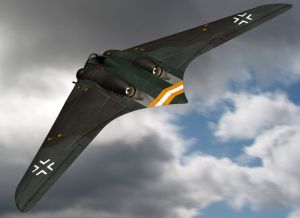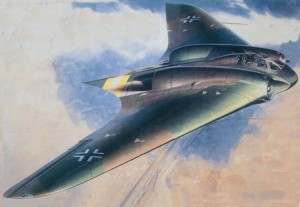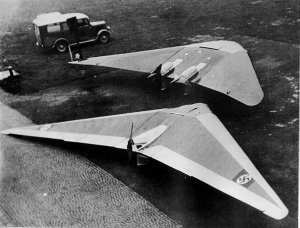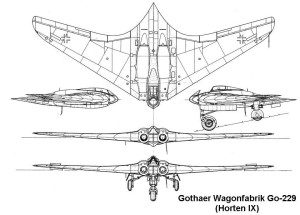Въпреки че не е напълно невидим за радарите, с “летящото крило” Horten Ho 229 нацистите можели да спечелят войната
Американските авиационни инженери на отбранителната корпорация Northrop-Grumman създадоха точно копие на подготвяния от нацистите в края на Втората световна война изтребител-бомбардировач по технологията “стелт” с формата на “летящо крило”, който да е невидим за радарите – 30 години преди САЩ да създадат първия си “невидим” самолет. 
Прототипът на Horten Ho 229 извършил успешен изпитателен полет през 1944 г., но за щастие Третия райх нямал необходимото технологично време за започването на серийното му производство и включването му във войната, съобщава британският ежедневник The Daily Mail.
Американският инженерен екип решил да провери на практика, дали Horten Ho 229 наистина щял да е невидим за тогавашните радари, като успял да създаде точно негово копие с помощта на конфискуваните чертежи на нацистките конструктори и единственият запазил се негов прототип. Моделът не бил предназначен за полети, но позволил проверката на способностите му да поглъща електромагнитните вълни. Документален филм за реконструкцията на “стелта” на Третия райх ще може да се види по телевизия National Geographic.
През 1943 г. сподвижниците на Хитлер започват да чувстват вкуса на поражението и се опитват да обърнат хода на войната с помощта на нови технологии в отбранителната промишленост, в т. ч. и в самолетостроенето.
Командващият “Луфтвафе” Херман Гьоринг поставил задачата за създаването на бомбардировач, който да достави товар от 1000 кг. бомби на разстояние поне 1000 км. при скорост от поне 1000 км./ч. Братята-конструктори и пилоти Раймар и Валтер Хортен (Reimar, Walter Horten) предложили създаването на “летящо крило”, което отговаряло на условията на Гьоринг. То било построено и тествано във въздуха за пръв път през март 1944 г., като било конструирано да има по-голяма скорост и обсег на действие от всчки построени дотогава самолети. 
Самолетът трябвало да се задвижва от 2 реактивни двигателя BMW 003, но истински революционната идея било предложението на Раймар Хортен той да бъде покрит със смес от прах от дървени въглища и дървесен клей, която да поглъща електромагнитното излъчване и заедно със специфичната му форма да го направи невидим за радарите. През 80-те години на миналия век американците използват подобни методи при създаването на първия си боен самолет по технологията “стелт” F-117A Nighthawk. Американският самолет е покрит с абсорбираща боя с високо съдържание на графит, който има сходен химически състав с този на дървените въглища.
За щастие, нацистките инженери успели да построят само 3 прототипа на самолета, които били изпитвани във въздуха посредством прикрепването им към планери. Заловените от американската армия чертежи на Horten Ho 229 били използвани като основа за собствените им “стелт”-разработки.
И досега обаче експертите се съмнявали, че предложените от братята Хортен нововъведения са били в състояние да направят самолета невидим за радарите. Затова екипът на Northrop-Grumman, създал “невидимият” бомбардировач B-2, с помощта на историческите чертежи и единствения оцелял прототип, успял да създаде пълноразмерно копие на Ho 229, което им струвало $ 250 000 и 2500 часа работа. 
Оказало се ,че самолетът не е напълно невидим за радарите от времето на Втората световна война, но бил достатъчно незабележим и бърз, за да достигне Лондон преди британците да успеят да вдигнат във въздуха изтребителите Spitfire, за да го прихванат. Благодарение на антирадарния си дизайн, Horten Ho 229 щял да съкрати времето за реакция на британските противовъздушни сили от 18 до 9 минути, в сравнение с конвенционалните бойни самолети.
“Ако германците имаха времето да произведат този самолет, той би могъл да се превърне в голям удар. Той е бил способен да развива невероятни за времето си скорости при немислима далечина на полета”, коментира авиационният експерт от британския Имперски военен музей в Дъксфорд (Duxford), Кеймбриджшир, Питър Мъртън (Peter Murton).
Hitler’s stealth bomber: How the Nazis were first to design a plane to beat radar
With its smooth and elegant lines, this could be a prototype for some future successor to the stealth bomber.
But this flying wing was actually designed by the Nazis 30 years before the Americans successfully developed radar-invisible technology.
Now an engineering team has reconstructed the Horten Ho 2-29 from blueprints, with startling results.

Blast from the past: The full-scale replica of the Ho 2-29 bomber was made with materials available in the 40s
 Futuristic: The stealth plane design was years ahead of its time
Futuristic: The stealth plane design was years ahead of its time
It was faster and more efficient than any other plane of the period and its stealth powers did work against radar.
Experts are now convinced that given a little bit more time, the mass deployment of this aircraft could have changed the course of the war.

The plane could have helped Adolf Hitler win the war
First built and tested in the air in March 1944, it was designed with a greater range and speed than any plane previously built
and was the first aircraft to use the stealth technology now deployed by the U.S. in its B-2 bombers.
Thankfully Hitler’s engineers only made three prototypes, tested by being dragged behind a glider, and were not able to build them on an industrial scale before the Allied forces invaded.
From Panzer tanks through to the V-2 rocket, it has long been recognised that Germany’s technilowcal expertise during the war was years ahead of the Allies.
But by 1943, Nazi high command feared that the war was beginning to turn against them, and were desperate to develop new weapons to help turn the tide.
Nazi bombers were suffering badly when faced with the speed and manoeuvrability of the Spitfire and other Allied fighters.
Hitler was also desperate to develop a bomber with the range and capacity to reach the United States.
In 1943 Luftwaffe chief Hermann Goering demanded that designers come up with a bomber that would meet his ‘1,000, 1,000, 1,000’ requirements – one that could carry 1,000kg over 1,000km flying at 1,000km/h.
A full scale replica of the Ho 229 bomber made with materials available in the 1940s at prefilght
A wing section of the stealth bomber. The jet intakes were years ahead of their time
Two pilot brothers in their thirties, Reimar and Walter Horten, suggested a ‘flying wing’ design they had been working on for years.
They were convinced that with its drag and lack of wind resistance such a plane would meet Goering’s requirements.
Construction on a prototype was begun in Goettingen in Germany in 1944.
The centre pod was made from a welded steel tube, and was designed to be powered by a BMW 003 engine.
The most important innovation was Reimar Horten’s idea to coat it in a mix of charcoal dust and wood glue.

Vengeful: Inventors Reimar and Walter Horten were inspired to build the Ho 2-29 by the deaths of thousands of Luftwaffe pilots in the Battle of Britain
The 142-foot wingspan bomber was submitted for approval in 1944, and it would have been able to fly from Berlin to NYC and back without refueling, thanks to the same blended wing design and six BMW 003A or eight Junker Jumo 004B turbojets
He thought the electromagnetic waves of radar would be absorbed, and in conjunction with the aircraft’s sculpted surfaces the craft would be rendered almost invisible to radar detectors.
This was the same method eventually used by the U.S. in its first stealth aircraft in the early 1980s, the F-117A Nighthawk.
The plane was covered in radar absorbent paint with a high graphite content, which has a similar chemical make-up to charcoal.
After the war the Americans captured the prototype Ho 2-29s along with the blueprints and used some of their technological advances to aid their own designs.
But experts always doubted claims that the Horten could actually function as a stealth aircraft.
Now using the blueprints and the only remaining prototype craft, Northrop-Grumman (the defence firm behind the B-2) built a fullsize replica of a Horten Ho 2-29.

Luckily for Britain the Horten flying wing fighter-bomber never got much further than the blueprint stage, above
Thanks to the use of wood and carbon, jet engines integrated into the fuselage, and its blended surfaces, the plane could have been in London eight minutes after the radar system detected it
It took them 2,500 man-hours and $250,000 to construct, and although their replica cannot fly, it was radar-tested by placing it on a 50ft articulating pole and exposing it to electromagnetic waves.
The team demonstrated that although the aircraft is not completely invisible to the type of radar used in the war, it would have been stealthy enough and fast enough to ensure that it could reach London before Spitfires could be scrambled to intercept it.
‘If the Germans had had time to develop these aircraft, they could well have had an impact,’ says Peter Murton, aviation expert from the Imperial War Museum at Duxford, in Cambridgeshire.
‘In theory the flying wing was a very efficient aircraft design which minimised drag.
‘It is one of the reasons that it could reach very high speeds in dive and glide and had such an incredibly long range.’
The research was filmed for a forthcoming documentary on the National Geographic Channel.
Filed under: военни технологии |







Вашият коментар